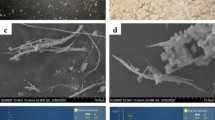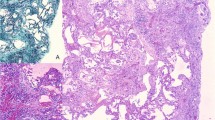Summary
Exposure to aerosols of organic dusts such as coffee, tea, spices, soy, fur, and animal food in an occupational setting can affect the respiratory health of industrial workers. Based on our experience with workers from many small industries processing organic materials, we discuss the clinical features and possible mechanisms responsible for the respiratory impairment associated with these types of dust exposure. Significantly higher prevalences for most chronic respiratory symptoms were found among exposed workers than among control workers. Smoking appears to aggravate these symptoms. A large number of exposed workers complained of acute symptoms which developed during the work shift. In exposed workers, significant across-shift reductions in lung function were recorded for all spirometric tests, but particularly for the flow rates at 50% and 25% of vital capacity on maximum expiratory flow-volume curves. Comparison of preshift measured ventilatory capacity tests with predicted normal values indicates that these workers demonstrate obstructive changes affecting primarily flow rate at low lung volumes. The data suggest that exposure to organic aerosols in industrial settings, particularly in conjunction with smoking, may be associated with the development of chronic obstructive lung disease.
Similar content being viewed by others
References
Allen J, Cooper D, Merrill WW, Buck MG, Schachter EN (1986) The relationship between bronchoalveolar neutrophil recruitment and bronchoconstriction induced by a soluble extract of cotton bracts. Am Rev Respir Dis 134:975–982
Beck GJ, Schachter EN, Maunder I (1984) Cotton dust and smoking effect on lung function in cotton textile workers. Am J Epidemiol 119:35–43
Bouhuys A, Lindell SE (1961) Release of histamine by dust extracts in vitro. Experientia 17:211–212
Bouhuys A, Zuskin E (1976) Chronic respiratory disease in hemp workers. Ann Intern Med 84:398–405
Boushey HA, Holtzman MJ, Sheller JR, Nadel JA (1980) Bronchial hyperreactivity 121:389–413
Brand PLP, Rijcken B, Schouten JP, Koeter GH, Weiss ST, Postma DS (1992) Perception of airway obstruction in a random population sample. Am Rev Respir Dis 146:396–401
Brooks SM (1985a) Occupational asthma. Chest 87:218S-222S
Brooks SM (1985b) Occupational asthma. In: (EB Weiss, Segal MS, Stein M (eds) Bronchial asthma, 2nd edn. Little, Brown & Co., Boston, pp 461–493
Brooks SM (1992) Occupational and environmental asthma. In: Rom WN (ed) Environmental and occupational medicine. Little, Brown & Co., Boston, pp 393–446
Brown DM, Donaldson K (1991) Injurious effects of wool and grain dusts on alveolar epithelial cells and macrophages in vitro. Br J Ind Med 48:196–202
Bush RK, Cohen M (1977) Immediate and late onset of asthma from occupational exposure to soy bean dust. Clin Allergy 7:369–373
Castellan RM, Boehlecke BA, Peterson MR, Thedell TD, Merchant JA (1981) Pulmonary function and symptoms in herbal tea workers. Chest 79:81S-85S
Castellan RM, Olenchock SA, Hankinson JG, Millner PD, Cocke JB, Bragg CK, Perkins HH, Jacobs RR (1984) Acute bronchoconstriction induced by cotton dust. Dose-related response to endotoxin and other dust factors. Ann Intern Med 101:157–163
Chan-Yeung M, Malo JL (1987) Occupational asthma. Chest 91:130S-136S
Donaldson K, Love RG, Cullen RT (1988) Inflammatory effects in the rat lung caused by dust collected from the air of British wool factories. Thorax 43:262P
Donham KJ (1990) Health effects from work in swine confinement buildings. Am J Ind Med 17:17–25
Donham KJ, Zavala DC, Merchant JA (1984) Respiratory symptoms and lung function among workers in swine confinement buildings: a cross-sectional epidemiological study. Arch Environ Health 39:96–101
Ferris BG (1978) Epidemiology standardization project. III. Recommended standardized procedures for pulmonary function testing. Am Rev Respir Dis 118:55–88
Ghio AJ, Castellan RM, Kinsley KB, Hankinson JL (1991) Changes in forced expiratory volume in one second and peak expiratory flow rate across a work shift among unexposed blue collar workers. Am Rev Respir Dis 143:1232–1234
Gross NJ (1980) Allergy to laboratory animals. Epidemiologic, clinical, and physiologic aspects, and a trial of cromolyn in its management. J Allergy Clin Immunol 66:158–165
Hargreave FE, Dolovich J, O'Byrne MB, Ramsdale EH, Daniel EE (1986) The origin of airway hyperresponsiveness. J Allergy Clin Immunol 78:825–832
Heederik D, Kromhout H, Kromhout D, Burema J, Biersteker K (1992) Relations between occupation, smoking, lung function, and incidence and mortality of chronic non-specific lung disease: the Zutphen study. Br J Ind Med 49:299–308
Holtzman MJ, Fabri LM, O'Bryne PM, Gold BD, Aizawa H, Walters EH, Alpert SE, Nadel JA (1983) Importance of airway inflammation for hyperresponsiveness induced by ozone. Am Rev Respir Dis 127:686–690
Iversen M, Pedersen B, Dahl R (1990) Relationship between respiratory symptoms and bronchial hyperreactivity in pig farmers. Am J Ind Med 17:64–65
Jones RN, Hughes JM, Lehrer SB, Butcher BT, Glindmeyer HW, Diem JE, Hammad YY, Salvaggio J, Weil H (1982) Lung function consequences of exposure and hypersensitivity in workers who process green coffee beans. Am Rev Respir Dis 125:199–202
Kanceljak-Macan B, Zuskin E, Godnic-Cvar J (1990) Bronchial reactivity to tea dust in healthy subjects. Period Biol 92:355–361
Kaye M, Freedman SD (1961) Allergy to raw coffee — an occupational disease. Can Med Assoc J 84:496–471
Kryzanowski M, Jedrychowski W, Wysocki M (1986) Factors associated with the change in ventilatory function and the development of chronic obstructive pulmonary disease in a 13-year follow-up of the Cracow study. Am Rev Respir Dis 134:1011–1019
Lerbowitz MD (1977) Occupational exposures in relation to symptomatology and lung function in a community population. Environ Res 14:59–67
Lutsky I, Baum GL, Teichtahl H, Mazar A, Aizer F, Bar-Sela S (1986) Respiratory disease in animal house workers. Eur J Respir Dis 69:29–35
Medical Research Council Committee on the Etiology of Chronic Bronchitis (1960) Standardized questionnaire on respiratory symptoms. Br Med J II:1665
Nava C, Brambilla G, Briatico-Vangosa M, Marchisio M, Talamo F (1983) Occupational asthma in food workers: study of three cases. Med Lav 74:302–307
Neuman I, Lutsky II (1976) Laboratory animal dander allergy. II. Clinical studies and the potential protective effect of disodium cromoglycate. Ann Allergy 36:23–29
Neuman Taylor AJ (1988) Occupational asthma. Postgrad Med J 64:505–510
Novembre E, Martino M de, Vierucci A (1988) Foods and respiratory allergy. J Allergy Clin Immunol 81:1059–1065
Pepys J (1982) Occupational asthma: an overview. J Occup Med 24:534–538
Pepys J, Hutchcroft BJ (1975) Bronchial provocation tests in etiologic diagnosis and analysis of asthma. Am Rev Respir Dis 112:829–859
Perrin B, Lagier F, L'Archeveque J, Cartier A, Boulet LP, Cote J, Malo JL (1992) Occupational asthma: validity of monitoring of peak expiratory flow rates and non-allergic bronchial responsiveness as compared to specific inhalation challenge. Eur Respir J 5:40–48
Quanjer P (1983) Standardized lung function testing. Bull Eur Physiopath Respir (Suppl 5) 19:1–95
Rohrbach MS, Rolastad RA, Russell JA (1986) Tannin is the major agent present in cotton mill dust responsible for human platelet 5-hydroxytriptamine secretion and thromboxane formation. Lung 164:187–197
Rylander R (1981) Bacterial toxins and the etiology of byssinosis. Chest [Suppl] 79:34–38
Rylander R (1990) Health effects of cotton dust exposures. Am J Ind Med 17:39–45
Schachter EN, Zuskin E, Buck MG, Witek TJ, Beck GJ, Tyler D (1985) Comparison of airway response to cotton bract extract with inhaled methacholine and metaproterenol. Chest 87:51–55
Sunyer J, Rodrigo MJ, Anto JM, Morell F (1989) Case control study of serum immunoglobulin E antibodies with soybean in epidemic asthma. Lancet I:179–182
Toorenenbergen AW, Dieges PH (1985) Immunoglobulin E antibodies against coriander and other species. J Allergy Clin Immunol 76:477–481
Uragoda CG (1967) Symptoms among chili grinders. Br J Ind Med 24:162–164
Uragoda CG (1980) Respiratory disease in tea workers in Sri Lanka. Thorax 35:114–117
Uragoda CG (1984) Asthma and other symptoms in cinnamon workers. Br J Ind Med 41:224–227
Valic F, Zuskin E (1972) Effects of different vegetable dust exposures. Br J Ind Med 29:293–297
Valic F, Zuskin E, Watford J, Kersic W, Paukovic R (1968) Byssinosis, chronic bronchitis and ventilatory capacities in workers exposed to soft hemp dust. Br J Ind Med 25:176–186
Widdicombe JG (1954) Receptors in the trachea and bronchi in the cat. J Physiol (Lond) 123:71–104
Witek TJ, Mazzara CA, Zuskin E, Beck GJ, Buck MG, Schachter EN (1988) Bronchial responsiveness after inhalation of cotton bract extract. Am Rev Respir Dis 138:1579–1583
World Health Organization (1986) Early detection of occupational disease. WHO, Geneva, pp 35–39
Xu X, Christiani C, Dockery DW, Wang L (1992) Exposure-response relationships between occupational exposures and chronic respiratory illness: a community-based study. Am Rev Respir Dis 146:413–418
Zuskin E, Bouhuys A (1975) A byssinosis: airway responses in textile dust exposure. J Occup Med 17:357–359
Zuskin E, Skuric Z (1984) Respiratory function in tea workers. Br J Ind Med 41:88–93
Zuskin E, Valic F, Bouhuys A (1976) Byssinosis and airway responses due to exposure to textile dust. Lung 154:17–24
Zuskin E, Valic F, Skuric Z (1979) Respiratory function in coffee workers. Br J Ind Med 36:117–122
Zuskin E, Skuric Z, Kanceljak B, Pokrajac D, Schachter EN, Witek TJ (1988a) Respiratory symptoms and ventilatory capacity in soy bean workers. Am J Ind Med 14:157–165
Zuskin E, Skuric Z, Kanceljak B, Pokrajac D, Schachter EN, Witek TJ (1988b) Respiratory findings in spice factory workers. Arch Environ Health 43:335–339
Zuskin E, Skuric Z, Kanceljak B, Pokrajac D, Schachter EN, Wittek TJ (1988c) Respiratory symptoms and lung function in furriers. Am J Ind Med 14:189–196
Zuskin E, Mataija M, Pokrajac D, Schachter EN, Witek TJ (1989) Respiratory function in animal food processing workers. Am J Ind Med 16:179–187
Zuskin E, Kanceljak B, Witek TJ, Schachter EN (1991a) Acute ventilatory response to green coffee dust extract. Ann Allergy 66:219–224
Zuskin E, Kanceljak B, Schachter EN, Mustajbegovic J, Goswami S, Maayani S, Marom Z, Rienzi N (1991b) Immunological and respiratory findings in swine farmers. Environ Res 56:120–130
Zuskin E, Kanceljak B, Schachter EN, Witek TJ, Marom Z, Goswami S, Maayani S (1991c) Immunological and respiratory changes in soy bean workers. Int Ach Occup Environ Health 63:15–20
Zuskin E, Kanceljak B, Schachter EN, Witek TJ, Maayani S, Goswami S, Marom Z, Rienzi N (1992a) Immunological and respiratory changes in animal food processing workers. Am J Ind Med 21:177–191
Zuskin E, Kanceljak B, Stilinovic L, Schachter EN, Kopjar B (1992b) Immunological status and respiratory findings in furriers. Am J Ind Med 21:433–441
Author information
Authors and Affiliations
Rights and permissions
About this article
Cite this article
Zuskin, E., Schachter, E.N., Kanceljak, B. et al. Organic dust disease of airways. Int. Arch Occup Environ Heath 65, 135–140 (1993). https://doi.org/10.1007/BF00405733
Received:
Accepted:
Issue Date:
DOI: https://doi.org/10.1007/BF00405733




